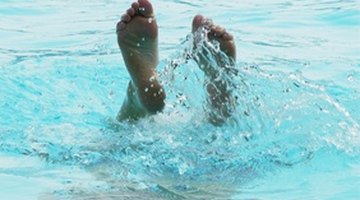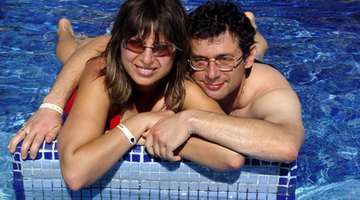How to Build a Swimming Pool With Besser Bricks
If you've ever thought you'll never be able to save enough to order that swimming pool your family is asking for, consider constructing it yourself with Besser blocks, cement blocks designed with hollow centers to accept poured cement for a strong, integrated swimming-pool structure.

With the flexibility to choose your own pool dimensions and depth, you can create anything from a one-lane lap pool to a neighborhood swimming destination. With some careful planning, adequate backyard space and a few a la carte professional services, you can build a pool to rival any professional job.
Things You Will Need
- Excavated pool site
- 2-by-4 pieces of lumber
- Besser bricks
- Level
- Plumb line
- Mortar
- Trowel
- Pipe
- Gravel
- Metal mesh fabric
- Steel rebar
- Cement
- Tile or other finishing material
Tip
Site your pool where it will receive sunlight most of the day. Use passive or active solar energy to heat the water.
-
Create a cement pad around the perimeter of your excavated pool site where you'll lay the Besser block walls; the pad should be approximately 3 inches thick and 8 inches wide. Use pieces of 2-by-4 lumber to create lengthwise boundaries to contain the wet cement until it cures (around two to three days); remove the lumber.
-
Prepare the mortar. Trowel, or smooth, a layer of mortar on top of the cement pad, one section at a time, and then place a base layer of 20.45 Besser blocks; you'll be using the 20.45 bricks only on the first round of the pool walls to enable the cement applied later to flow smoothly from the floor of the pool and up the first bricks in the walls without a joint. The 20.45 Besser blocks have two open cavities to form an "E" shape where cement can flow in. As you place the blocks, they should be touching side to side; you won't put mortar between them. Check for level with a level. Check the straightness of each row with a plumb line by holding one end of the string against the end block and the other end against the block at the opposite end. The line should be straight against each block in the row.
-
Continue with the second row, this time using 20.48 Besser blocks—"H" blocks—and 20.21 corner bond beam Bessers at each corner. The corner blocks have end and side panels that can be removed, or knocked out, to accommodate the flow of cement later in the process. Knock out the end of the corner block adjacent to the wall it's completing, and the side of the block adjacent to the next pool side. This and each subsequent row should be mortared in the bed joints—only between rows.
-
Continue placing blocks atop the mortared top of the previous row until you reach the final row. Make certain that during construction that the Besser bricks are not exposed to moisture; cover them at night or during inclement weather to keep them dry. Also take care to wipe off excess mortar from the walls as you build.
-
Place the top course using 20.62 Besser blocks—"C" shaped piers—place the top course with the open sides of the bricks facing outward—this block configuration allows you to finish the top edge with coping tile or a poured walkway. Glue these 20.62 bricks to the previous course of 20.48 blocks using a waterproof adhesive designed for this usage. Also apply adhesive between blocks on this top row only. Be sure to leave out a block or two at one end of the pool, where you'll place a skimmer basket.
-
Call a plumber to install the pool drain piping and the filter pipe. The plumber should not put pipes within the brick walls but under the wall to the outside, since pipes within the wall would compromise its structural strength by forming air pockets.
-
Line the bottom of the swimming pool with a bed of gravel about 3 inches thick. Place a plastic vapor barrier, cut to size, on the bed of gravel. Next lay the metal mesh reinforcement material on top. Place L-shaped rebar "starter" bars with one end inside the wall and the other end connected to the mesh reinforcement layer. Place steel rebar cut to height from within each top brick, extending to the base of the wall. Consult a concrete expert for advice, if needed.
-
Call for a cement truck to pump in cement for the pool floor. Make sure that the cement technicians vibrate the substance into place, and also that the substance fills in the base course of Besser wall bricks. Unless you're skilled at cement finishing, have the experts finish the surface, making sure that the pool floor is seamlessly bonded to the first course of the side walls by creating a curved surface where the two meet. Have additional cement poured into the block cavities from the top, checking to eliminate air pockets and completely filling the blocks.
-
Allow the cement to cure completely. Call in a contractor to tile, plaster, or paint the interior of the pool if you so desire. Add water.



The Drip Cap
- If you've ever thought you'll never be able to save enough to order that swimming pool your family is asking for, consider constructing it yourself with Besser blocks, cement blocks designed with hollow centers to accept poured cement for a strong, integrated swimming-pool structure.
- Trowel, or smooth, a layer of mortar on top of the cement pad, one section at a time, and then place a base layer of 20.45 Besser blocks; you'll be using the 20.45 bricks only on the first round of the pool walls to enable the cement applied later to flow smoothly from the floor of the pool and up the first bricks in the walls without a joint.
- Check for level with a level.
- Also apply adhesive between blocks on this top row only.
- Call a plumber to install the pool drain piping and the filter pipe.
- Place a plastic vapor barrier, cut to size, on the bed of gravel.
- Next lay the metal mesh reinforcement material on top.
- Unless you're skilled at cement finishing, have the experts finish the surface, making sure that the pool floor is seamlessly bonded to the first course of the side walls by creating a curved surface where the two meet.
Writer Bio
I have an MFA degree in Creative Writing and am a published poet who has received several poetry awards. I have established a reputation as an environmental activist, both through the group I co-founded -- see alternativeone.org -- and through a series of op-ed pieces in Montana newspapers. I have written extensively on alternative energy, recycling and endangered species.
Photo Credits
- Aerial View of Swimmers in Summer Pool image by nextrecord from Fotolia.com
- Aerial View of Swimmers in Summer Pool image by nextrecord from Fotolia.com
- feet out of water image by sonya etchison from Fotolia.com
- boy in swimming-pool image by Marzanna Syncerz from Fotolia.com
- good looking couple in the pool image by Galina Barskaya from Fotolia.com
More Articles



